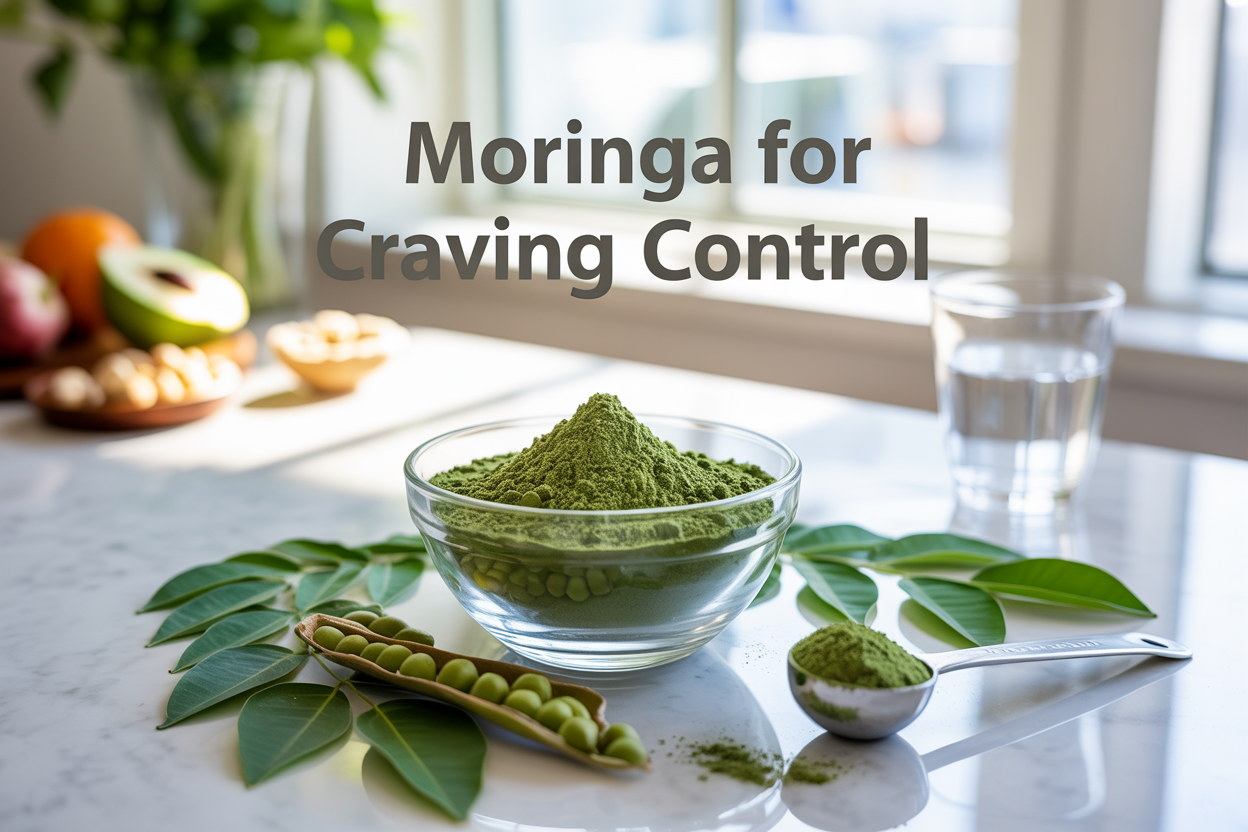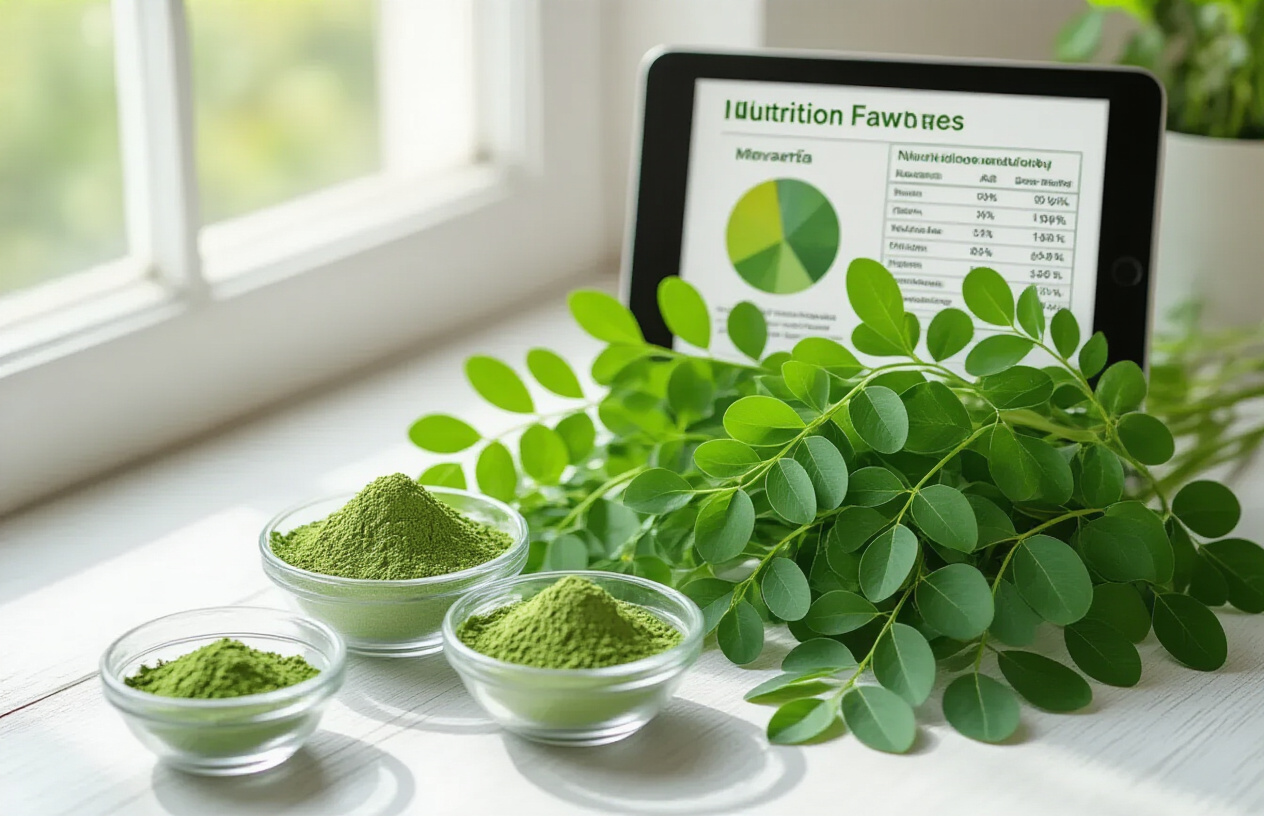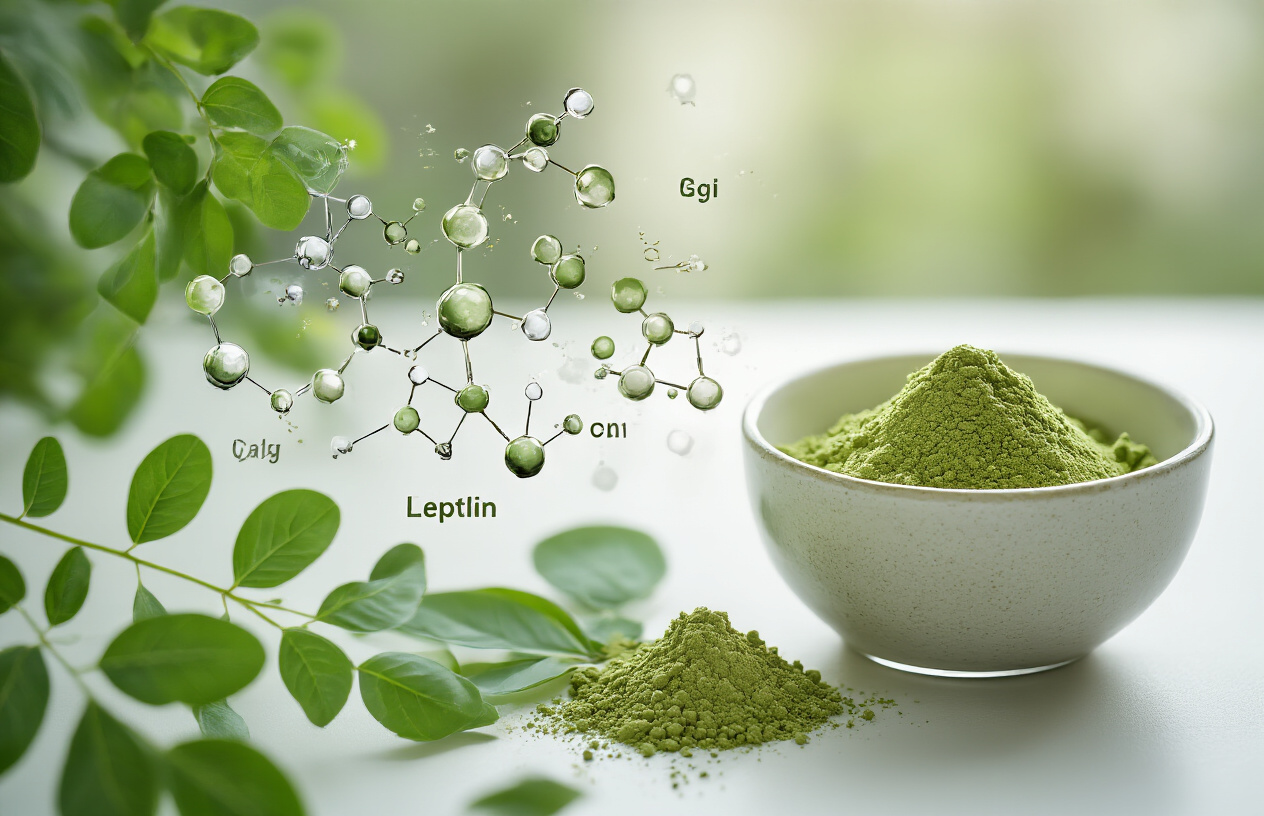
Struggling with food cravings that sabotage your weight loss goals? You’re not alone, and there’s a natural solution that might help. Moringa weight loss has gained attention as a powerful tool for craving control, and research shows this nutrient-dense superfood can be your ally in the battle against unwanted pounds.
Who this is for: If you’re tired of fighting constant hunger pangs, dealing with energy crashes that trigger snack attacks, or looking for natural appetite control supplements that actually work, this guide is for you.
You’ll discover how moringa appetite suppressant properties work through multiple pathways in your body. We’ll explore how this green powder helps with moringa blood sugar control to stop those sugar spikes that leave you reaching for more food. You’ll also learn about moringa’s ability to balance your hunger hormones, giving you better control over when and how much you eat.
By the end, you’ll know exactly how to control food cravings naturally using moringa, plus practical tips for incorporating this powerful plant into your daily routine for sustainable weight management.
Understanding Food Cravings and Their Impact on Weight Gain

The Science Behind Food Cravings and Hunger Hormones
Your body operates like a complex messaging system when it comes to hunger and cravings. Two key hormones control this process: leptin and ghrelin. Leptin, produced by your fat cells, signals when you’re full and should stop eating. Ghrelin, released by your stomach, triggers hunger and tells your brain it’s time to eat.
When these hormones fall out of balance, you experience intense food cravings that seem impossible to resist. Your leptin sensitivity decreases when you’re constantly exposed to processed foods, making it harder for your brain to recognize fullness signals. Meanwhile, your ghrelin levels spike unpredictably, creating sudden urges for high-calorie foods.
Your brain’s reward center also plays a crucial role. When you eat certain foods, particularly those high in sugar and fat, your brain releases dopamine – the same neurotransmitter involved in addiction. This creates a cycle where you need increasingly more of these foods to achieve the same satisfaction level.
Chronic stress compounds this problem by elevating cortisol levels, which directly increases your appetite and drives cravings for comfort foods. When you’re stressed, your body literally programs itself to seek out calorie-dense foods as a survival mechanism.
How Processed Foods Trigger Addictive Eating Patterns
Processed foods are engineered to bypass your natural satiety signals. Food manufacturers spend millions researching the perfect combination of salt, sugar, and fat – what they call the “bliss point” – designed to keep you coming back for more.
These foods cause rapid spikes in your blood sugar, followed by dramatic crashes that leave you craving more within hours. Your brain interprets these crashes as hunger, even when your body has adequate energy stores. This rollercoaster effect creates a dependency that’s remarkably similar to substance addiction.
The texture and flavor intensity of processed foods also overwhelm your taste buds. When you regularly consume these hyperpalatable foods, natural whole foods start tasting bland and unsatisfying. Your palate becomes conditioned to expect extreme flavors and textures, making it difficult to feel satisfied with nutritious, unprocessed options.
Artificial additives in processed foods can disrupt your gut bacteria, which directly communicate with your brain about hunger and satiety. An imbalanced gut microbiome sends confused signals about when and how much to eat, contributing to persistent cravings and overeating.
The Connection Between Blood Sugar Spikes and Increased Appetite
Your blood sugar levels directly control your appetite and energy throughout the day. When you eat foods high in refined carbohydrates or sugar, your blood glucose shoots up rapidly. Your pancreas responds by releasing large amounts of insulin to bring these levels down.
This insulin surge often overshoots, causing your blood sugar to drop below normal levels – a condition called reactive hypoglycemia. Your brain interprets this drop as an emergency and triggers intense hunger signals, particularly for quick-energy foods like sweets and refined carbs.
These blood sugar roller coasters happen multiple times daily when your diet includes processed foods, keeping you in a constant state of craving. You might eat a large meal and feel hungry again within two hours, not because you need more calories, but because your blood sugar has crashed.
Your body also starts producing more insulin over time to handle these frequent spikes. This insulin resistance makes it even harder to control your appetite and leads to increased fat storage, particularly around your midsection.
Why Traditional Dieting Methods Fail to Control Cravings
Most diet approaches focus on restricting calories without addressing the underlying hormonal imbalances that drive your cravings. When you simply reduce portion sizes while continuing to eat the same types of foods, you’re fighting against your body’s natural regulatory systems.
Extreme calorie restriction actually makes cravings worse by triggering your body’s starvation response. Your metabolism slows down, your hunger hormones become more aggressive, and your brain becomes hyperfocused on food. This biological rebellion against restriction explains why you might find yourself obsessing about food when dieting.
Many popular diets also eliminate entire food groups without providing adequate nutrition. When your body lacks essential nutrients, it generates cravings as a way to seek out what it needs. You might interpret these nutrient-driven cravings as general hunger and end up overeating foods that don’t actually address the deficiency.
The willpower-based approach to dieting ignores the fact that hunger and cravings are largely controlled by hormones and brain chemistry, not just conscious choice. Fighting against these powerful biological signals with willpower alone is like trying to hold your breath indefinitely – eventually, your body’s programming will override your conscious efforts.
Moringa’s Nutritional Profile for Appetite Control

High Protein Content That Promotes Satiety
When you’re trying to manage your weight, protein becomes your best friend, and moringa delivers it in impressive amounts. With approximately 25% protein by weight, moringa leaves contain all nine essential amino acids your body needs. This complete protein profile sets moringa apart from most plant-based sources and makes it a powerful natural appetite control supplement.
Your body processes protein differently than carbs or fats, requiring more energy to digest and metabolize it. This process, called the thermic effect of food, naturally boosts your metabolism while keeping you satisfied longer. The protein in moringa triggers the release of satiety hormones like GLP-1 and PYY, which send “full” signals to your brain and help reduce those persistent food cravings.
Adding just two tablespoons of moringa powder for weight loss to your daily routine provides about 6-8 grams of high-quality protein. This protein content helps stabilize your energy levels throughout the day, preventing those afternoon crashes that often lead to unhealthy snacking.
Rich Fiber Content for Prolonged Fullness
Your digestive system loves fiber, and moringa provides plenty of it. With roughly 20% fiber content, moringa leaves help you feel full and satisfied for extended periods. This fiber works by expanding in your stomach when mixed with liquids, creating a natural sense of fullness that can last for hours.
The fiber in moringa also slows down digestion, which helps prevent rapid spikes in blood sugar that trigger cravings. When you consume moringa before meals, the fiber creates a gel-like substance in your stomach that physically takes up space and sends satiety signals to your brain.
Soluble fiber in moringa also feeds your beneficial gut bacteria, supporting a healthy microbiome that plays a role in appetite regulation. A balanced gut environment helps your body produce the right hunger and fullness hormones, making moringa appetite suppressant effects even more effective.
Essential Vitamins and Minerals That Reduce Nutrient Deficiencies
Your cravings often stem from nutrient deficiencies rather than true hunger. When your body lacks essential vitamins and minerals, it sends hunger signals to encourage you to seek out the nutrients it needs. Moringa’s impressive nutritional density helps fill these gaps naturally.
Moringa contains seven times more vitamin C than oranges, four times more calcium than milk, and three times more potassium than bananas. It’s also rich in iron, magnesium, and B-vitamins that support energy metabolism. When your body gets these essential nutrients, those nagging cravings for processed foods often disappear.
| Nutrient | Amount per 100g | Daily Value % |
|---|---|---|
| Vitamin A | 8,424 IU | 168% |
| Vitamin C | 220 mg | 367% |
| Calcium | 440 mg | 44% |
| Iron | 25.6 mg | 142% |
| Magnesium | 42 mg | 11% |
The B-vitamins in moringa, particularly B6 and folate, help your body produce neurotransmitters like serotonin that regulate mood and appetite. When these levels are balanced, you’re less likely to experience emotional eating or stress-induced cravings.
Low Calorie Density for Guilt-Free Consumption
One of moringa’s biggest advantages for moringa weight loss is its incredibly low calorie content. A typical serving of moringa powder contains only about 25-30 calories while delivering substantial nutrition. This means you can consume it regularly without worrying about adding excess calories to your daily intake.
The low calorie density allows you to use moringa generously in smoothies, teas, and meals without derailing your weight loss goals. You get maximum nutritional benefits with minimal caloric impact, making it an ideal addition to any moringa for weight management plan.
This calorie-to-nutrition ratio is what nutritionists call “nutrient density,” and moringa ranks among the highest. When you reduce food cravings naturally with nutrient-dense foods like moringa, you satisfy your body’s nutritional needs without overconsumming calories. This approach supports sustainable weight loss while maintaining your energy and health.
How Moringa Regulates Blood Sugar to Reduce Cravings

Natural compounds that slow glucose absorption
Your body processes sugar differently when you consume moringa alongside your meals. The leaf contains isothiocyanates and chlorogenic acids that act like natural brakes on your digestive system. These compounds slow down the enzymes responsible for breaking down carbohydrates, which means glucose enters your bloodstream at a gentler, more controlled pace.
When you eat refined carbs or sugary foods without moringa, your blood sugar spikes rapidly. This creates a roller coaster effect that leaves you craving more food within hours. Moringa’s natural compounds help flatten this curve, giving your body time to process nutrients without the dramatic ups and downs that trigger intense hunger.
Stabilizing insulin levels throughout the day
Consistent insulin levels are your secret weapon against food cravings. When you maintain steady insulin, your body doesn’t panic about energy storage or release. Moringa helps your cells respond more effectively to insulin, which means better glucose uptake and less insulin floating around in your system.
You’ll notice this stability most during your typical craving windows – mid-afternoon or late evening. Instead of feeling that familiar energy dip that sends you searching for snacks, your blood sugar remains more balanced. This natural appetite control happens because your insulin isn’t constantly spiking and crashing, demanding quick energy fixes.
Regular moringa consumption supports your pancreas in producing just the right amount of insulin. Your cells become more sensitive to insulin signals, creating an efficient system that doesn’t overreact to the food you eat.
Preventing energy crashes that trigger hunger
Energy crashes are hunger’s best friend. When your blood sugar drops too quickly, your brain sends urgent signals demanding immediate fuel – usually in the form of quick carbs or sugar. Moringa’s blood sugar control properties help you avoid these dramatic dips that make you feel ravenous.
Your energy levels stay more consistent throughout the day when moringa is part of your routine. Instead of riding the blood sugar roller coaster, you experience:
- Fewer mid-morning energy slumps
- Reduced afternoon fatigue that leads to snacking
- Better focus without needing frequent food breaks
- More stable mood without hunger-induced irritability
This steady energy supply means you’re less likely to reach for processed snacks or make impulsive food choices when your body thinks it needs quick energy.
Supporting healthy metabolism for consistent energy
A well-functioning metabolism keeps your energy production smooth and efficient. Moringa supports several metabolic pathways that help your body convert food into usable energy without creating the conditions for excessive hunger. The plant’s rich nutrient profile provides cofactors your metabolism needs to work optimally.
Your metabolic efficiency improves when you have adequate B vitamins, magnesium, and other nutrients found in moringa. These support the cellular processes that turn food into energy, reducing the likelihood of metabolic slowdowns that can increase appetite as your body seeks more fuel to compensate for inefficient energy production.
Better metabolism also means your body can access stored fat for energy more easily, reducing the urgent hunger signals that drive overeating. This metabolic support makes moringa particularly effective for sustainable weight management rather than quick fixes that often backfire.
Moringa’s Role in Balancing Hunger Hormones

Regulating ghrelin production for reduced appetite
Your body produces ghrelin, often called the “hunger hormone,” when your stomach is empty. This powerful chemical messenger travels to your brain and essentially screams “feed me now!” But here’s where moringa weight loss benefits really shine – the superfood’s unique nutritional profile helps keep ghrelin levels in check.
When you consume moringa powder, you’re flooding your system with essential nutrients that signal satisfaction to your brain. The high protein content (around 25% by weight) plays a crucial role here. Your body recognizes this nutritional density and naturally reduces ghrelin production, meaning you won’t experience those intense hunger pangs that derail your weight management goals.
The chromium found in moringa also supports this process by helping your cells respond better to insulin. When your blood sugar remains stable, your ghrelin levels follow suit, creating a natural appetite suppressant effect without any synthetic additives.
Supporting leptin sensitivity for better satiety signals
Leptin works as your body’s built-in “stop eating” signal, but many people develop leptin resistance over time. This means your brain can’t properly hear the message that you’re full, leading to overeating and weight gain. Moringa’s anti-inflammatory compounds help restore your leptin sensitivity.
The antioxidants in moringa, particularly quercetin and chlorogenic acid, reduce inflammation in your hypothalamus – the brain region responsible for processing leptin signals. When inflammation decreases, your brain can once again recognize when you’ve had enough to eat.
You’ll notice this improved leptin function as a natural reduction in portion sizes and fewer between-meal cravings. Your body becomes better at distinguishing true hunger from emotional or habitual eating patterns.
Optimizing cortisol levels to prevent stress eating
Chronic stress wreaks havoc on your weight loss efforts by elevating cortisol levels. High cortisol doesn’t just make you crave sugary, fatty comfort foods – it also tells your body to store fat, particularly around your midsection.
Moringa contains adaptogenic properties that help your body manage stress more effectively. The magnesium content supports your nervous system, while compounds like isothiocyanates help regulate your stress response at the cellular level.
When you include moringa in your daily routine, you’re giving your body natural tools to control food cravings that stem from stress. Instead of reaching for junk food during challenging moments, your regulated cortisol levels help you make clearer, more conscious food choices that support your weight management goals.
Practical Ways to Use Moringa for Craving Control

Optimal Timing for Maximum Appetite Suppression Benefits
Your moringa timing can make or break your weight loss success. Take moringa powder 30-45 minutes before your largest meals of the day to get the best appetite control results. This timing allows the nutrients to enter your bloodstream and begin stabilizing your blood sugar levels before you start eating.
For breakfast, mix your moringa dose into water or a smoothie as soon as you wake up. Your body has been fasting overnight, making it the perfect time for maximum nutrient absorption. This morning dose helps control mid-morning snack attacks that often derail weight loss efforts.
If you’re dealing with afternoon cravings, take a second dose around 2-3 PM. This strategic timing helps bridge the gap between lunch and dinner, preventing the energy crash that typically leads to grabbing processed snacks from the office vending machine.
Avoid taking moringa too close to bedtime, as its energizing properties might interfere with your sleep. Poor sleep disrupts hunger hormones like ghrelin and leptin, making craving control much harder the next day.
Recommended Daily Dosages for Weight Loss Goals
Start with 1-2 teaspoons of moringa powder daily if you’re new to this natural appetite suppressant. Your body needs time to adjust to the concentrated nutrients, and jumping in with too much too fast can cause digestive upset.
After the first week, you can increase to 1 tablespoon (about 7 grams) daily, split between two doses. This amount provides enough bioactive compounds to support hunger hormone balance without overwhelming your system.
| Weight Loss Goal | Daily Moringa Dosage | Frequency |
|---|---|---|
| Gentle appetite control | 1-2 teaspoons | Once daily |
| Moderate craving reduction | 1 tablespoon | Split into 2 doses |
| Intensive weight management | 1.5 tablespoons | 3 smaller doses |
For intensive weight loss goals, you might work up to 1.5 tablespoons daily, but this should be split into three smaller doses throughout the day. Never exceed 2 tablespoons daily, as your body can only process so much at once, and excess amounts won’t provide additional benefits.
Combining Moringa with Other Natural Appetite Suppressants
Moringa pairs beautifully with other natural ingredients to create a powerful craving-control combination. Green tea makes an excellent partner – brew a cup of green tea and mix in your moringa powder. The caffeine provides additional appetite suppression while the antioxidants work together to boost metabolism.
Apple cider vinegar and moringa create another winning combination. Mix 1 teaspoon of moringa powder with 1 tablespoon of apple cider vinegar in a glass of water. Drink this mixture 30 minutes before meals to maximize blood sugar control and reduce food cravings naturally.
Adding fiber-rich ingredients amplifies moringa’s appetite-suppressing effects. Blend moringa with chia seeds, flaxseed, or psyllium husk in your morning smoothie. These combinations help you feel fuller longer while providing sustained energy throughout the day.
Cinnamon enhances moringa’s blood sugar stabilizing properties. Sprinkle both into your coffee, oatmeal, or yogurt for a tasty way to control hunger between meals. This combination works especially well for people who struggle with sugar cravings.
Simple Recipes and Preparation Methods for Daily Use
Your moringa weight loss journey becomes sustainable when you have easy, tasty ways to incorporate it daily. The simplest method is mixing moringa powder into room temperature water with a squeeze of lemon. This basic drink takes 30 seconds to prepare and delivers immediate appetite control benefits.
Create a morning appetite-control smoothie by blending:
- 1 tablespoon moringa powder
- 1 cup unsweetened almond milk
- 1/2 banana
- 1 tablespoon almond butter
- Handful of spinach
- Ice cubes
This smoothie provides protein, healthy fats, and fiber alongside moringa’s appetite-suppressing compounds, keeping you satisfied until lunch.
For afternoon cravings, prepare moringa energy balls ahead of time. Mix 2 tablespoons moringa powder with 1 cup dates, 1/2 cup nuts, and 1 tablespoon coconut oil in a food processor. Roll into balls and refrigerate. These provide a natural sweet treat that actually helps reduce future cravings.
Tea lovers can create moringa appetite control tea by mixing 1 teaspoon moringa powder with hot water, adding ginger and honey to taste. This warm, comforting drink works perfectly for evening cravings when you want something satisfying but not heavy.
Store prepared moringa drinks in the refrigerator for up to 24 hours, but fresh preparation gives you the most potent appetite-suppressing benefits for your weight management goals.
Real Results: Expected Timeline and Sustainable Weight Loss

Week-by-week changes in appetite and cravings
Your first week with moringa might feel subtle, but your body is already starting to respond. You’ll likely notice fewer mid-afternoon energy crashes, which naturally reduces those 3 PM sugar cravings that usually send you to the vending machine. Your breakfast might keep you satisfied longer, pushing lunch back by an hour without that gnawing hunger.
Week two brings more noticeable changes in your moringa appetite suppressant effects. Those late-night snack attacks become less frequent, and you might find yourself naturally reaching for smaller portions. Your blood sugar feels more stable throughout the day, meaning fewer dramatic hunger spikes that make you grab whatever’s closest.
By week three, your relationship with food starts shifting. Cravings for processed snacks lose their grip, and you’ll find yourself genuinely wanting healthier options. This isn’t willpower – it’s your body responding to better nutrition and balanced hunger hormones that moringa helps regulate.
Week four and beyond show the real power of moringa for weight management. Your appetite feels normal and manageable. Those overwhelming urges to eat when you’re stressed or bored become rare occurrences rather than daily battles. You’ll notice you can walk past your trigger foods without the internal struggle you used to face.
Realistic weight loss expectations with moringa supplementation
Expecting moringa weight loss results requires realistic timelines. You won’t drop 10 pounds in your first week – that’s not how sustainable weight loss works. Instead, you’re looking at 1-2 pounds per week when combined with sensible eating habits.
Your initial weight loss might come from reduced bloating and water retention as moringa helps stabilize your blood sugar levels. This can show up as 3-5 pounds in the first two weeks, but don’t expect this rapid pace to continue.
Month one typically brings 4-6 pounds of genuine fat loss when you’re using moringa powder weight loss strategies consistently. This happens because you’re naturally eating less without feeling deprived, and your metabolism runs more efficiently with better nutrition.
| Timeline | Expected Weight Loss | Key Changes |
|---|---|---|
| Week 1-2 | 2-4 lbs | Reduced bloating, fewer cravings |
| Month 1 | 4-6 lbs | Stable appetite, better portion control |
| Month 2-3 | 8-12 lbs total | Sustained habits, metabolic improvements |
| Month 4+ | 12-20 lbs total | Long-term lifestyle changes |
Three to six months in, you’ll see the compound effect. Your body has adapted to better nutrition, your cravings are under control, and weight loss becomes a natural byproduct of how you’re living rather than something you’re forcing.
Long-term benefits for maintaining healthy eating habits
The real magic happens when moringa becomes part of your daily routine for months, not weeks. Your taste buds actually change, making naturally sweet foods like fruits more appealing while processed foods start tasting too artificial or salty.
Natural appetite control supplements like moringa work best when they become invisible parts of your lifestyle. You stop thinking about them as weight loss tools and start seeing them as normal nutrition support. This shift in mindset creates lasting change rather than temporary fixes.
Your relationship with stress eating transforms completely. When life gets chaotic, you won’t automatically reach for comfort foods because your blood sugar stays stable and your hunger hormones remain balanced. This doesn’t mean you never enjoy treats, but you choose them consciously rather than compulsively.
Sleep quality improves as your blood sugar stabilizes, which directly impacts your hunger hormones the next day. Better sleep means better appetite control, creating a positive cycle that supports long-term weight maintenance.
Six months to a year later, you’ll find that maintaining healthy eating habits feels effortless. You’ve retrained your appetite response system, and hunger hormone balance becomes your natural state. The behaviors that once required willpower – like stopping when you’re full or choosing vegetables over chips – become automatic responses.
Your body learns to trust that it will get consistent, quality nutrition, so it stops triggering emergency hunger signals that used to drive overeating. This biological shift makes maintaining your weight loss significantly easier than traditional diet approaches that leave you fighting your natural hunger cues.

When you’re struggling with constant food cravings, moringa offers a natural solution that addresses the root causes rather than just masking the symptoms. This nutrient-packed superfood works on multiple levels—stabilizing your blood sugar, balancing hunger hormones like ghrelin and leptin, and providing your body with essential vitamins and minerals that often trigger cravings when missing. You can expect to see initial changes in your appetite within 2-4 weeks of consistent use, with more significant weight loss results developing over 2-3 months.
The key to success lies in making moringa a regular part of your daily routine. Start with small doses and gradually increase them while paying attention to how your body responds. Remember that sustainable weight loss isn’t about quick fixes—it’s about creating lasting changes in how your body manages hunger and satisfaction. By incorporating moringa powder into your morning smoothies, taking capsules before meals, or sipping moringa tea throughout the day, you’re giving your body the tools it needs to naturally reduce those overwhelming food cravings that have been holding you back from your weight loss goals.
